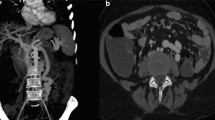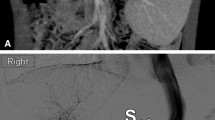Abstract
Purpose
A congenital extrahepatic portosystemic shunt (CEPS) associated with hyperammonemia requires occlusion of the shunt vessels. We evaluated the effectiveness and safety of laparoscopic ligation of a CEPS in children with hyperammonemia.
Methods
The subjects of this retrospective study were seven children with hyperammonemia who underwent laparoscopic ligation of a CEPS. Their median age was 5.2 years (range 1–16 years). Before the laparoscopic procedure, a catheter was inserted through the femoral vein and placed in the portal vein via the shunt vessel. The shunt vessel was dissected and taped laparoscopically. After measuring the portal vein pressure under temporal occlusion, the shunt vessels were ligated.
Results
The types of shunts according to location were patent ductus venosus (n = 2), splenorenal shunt (n = 2), gastrorenal shunt (n = 2), and superior mesenteric vein–inferior vena cava shunt (n = 1). Laparoscopic ligation of the shunt vessel was completed uneventfully in all patients. The median portal vein pressure was 19 mmHg after ligation. The median preoperative blood ammonia level was 94 µg/dL (range 71–259 µg/dL), which decreased after ligation in all patients. There was no incidence of postoperative liver failure.
Conclusion
Laparoscopic ligation of a CEPS is safe and effective for children with hyperammonemia.


Similar content being viewed by others
Abbreviations
- CPSS:
-
Congenital portosystemic shunt
- CEPS:
-
Congenital extrahepatic portosystemic shunt
References
Papamichail M, Pizanias M, Heaton N. Congenital portosystemic venous shunt. Eur J Pediatr. 2018;177:285–94.
Morgan G, Superina R. Congenital absence of the portal vein: two cases and a proposed classification system for portasystemic vascular anomalies. J Pediatr Surg. 1994;29:1239–41.
Sokollik C, Bandsma RH, Gana JC, van den Heuvel M, Ling SC. Congenital portosystemic shunt: characterization of a multisystem disease. J Pediatr Gastroenterol Nutr. 2013;56:675–81.
Bernard O, Franchi-Abella S, Branchereau S, Pariente D, Gauthier F, Jacquemin E. Congenital portosystemic shunts in children: recognition, evaluation, and management. Semin Liver Dis. 2013;32:273–87.
Hara Y, Sato Y, Yamamoto S, Oya H, Igarashi M, Abe S, et al. Successful laparoscopic division of a patent ductus venosus: report of a case. Surg Today. 2013;43:434–8.
Kimura T, Soh H, Hasegawa T, Sasaki T, Kuroda S, Yuri E, et al. Laparoscopic correction of congenital portosystemic shunt in children. Surg Laparosc Endosc Percutaneous Tech. 2004;14:285–8.
Kanazawa H, Nosaka S, Miyazaki O, Sakamoto S, Fukuda A, Shigeta T, et al. The classification based on intrahepatic portal system for congenital portosystemic shunts. J Pediatr Surg. 2015;50:688–95.
Yagi H, Takada Y, Fujimoto Y, Ogura Y, Kozaki K, Ueda M, et al. Successful surgical ligation under intraoperative portal vein pressure monitoring of a large portosystemic shunt presenting as an intrapulmonary shunt: report of a case. Surg Today. 2004;34:1049–52.
Lautz TB, Tantemsapya N, Rowell E, Superina RA. Management and classification of type II congenital portosystemic shunts. J Pediatr Surg. 2011;46:308–14.
Siegel D, Marder R, Palvanov A. Asymptomatic intrahepatic portosystemic venous shunt: to treat or not to treat? Int J Angiol. 2015;25:193–8.
Matsuura T, Takahashi Y, Yanagi Y, Yoshimaru K, Yamamura K, Morihana E, et al. Surgical strategy according to the anatomical types of congenital portosystemic shunts in children. J Pediatr Surg. 2016;51:2099–104.
Sanada Y, Urahashi T, Ihara Y, Wakiya T, Okada N, Yamada N, et al. The role of operative intervention in management of congenital extrahepatic portosystemic shunt. Surgery. 2011;151:404–11.
Kamimatsuse A, Onitake Y, Kamei N, Tajima G, Sakura N, Sueda T, et al. Surgical intervention for patent ductus venosus. Pediatr Surg Int. 2010;26:1025–30.
Kamata S, Kitayama Y, Usui N, Kuroda S, Nose K, Sawai T, et al. Patent ductus venosus with a hypoplastic intrahepatic portal system presenting intrapulmonary shunt: a case treated with banding of the ductus venosus. J Pediatr Surg. 2000;35:655–7.
Passalacqua M, Lie KT, Yarmohammadi H. Congenital extrahepatic portosystemic shunt (Abernethy malformation) treated endovascularly with vascular plug shunt closure. Pediatr Surg Int. 2011;28:79–83.
Papamichail M, Ali A, Quaglia A, Karani J, Heaton N. Liver resection for the treatment of a congenital intrahepatic portosystemic venous shunt. Hepatobiliary Pancreat Dis Int HBPD INT 2016;15:329–333
Author information
Authors and Affiliations
Corresponding author
Ethics declarations
Conflict of interest
Yuichi Takama and his co-authors have no conflicts of interest.
Rights and permissions
About this article
Cite this article
Takama, Y., Ueno, T., Umeda, S. et al. Laparoscopic ligation of a congenital extrahepatic portosystemic shunt for children with hyperammonemia: a single-institution experience. Surg Today 49, 323–327 (2019). https://doi.org/10.1007/s00595-018-1731-y
Received:
Accepted:
Published:
Issue Date:
DOI: https://doi.org/10.1007/s00595-018-1731-y




